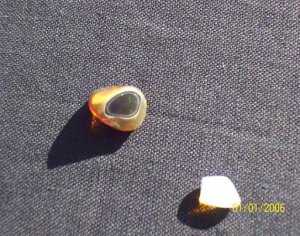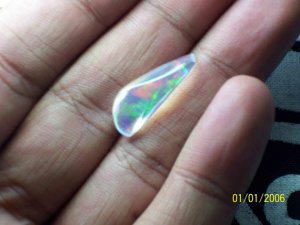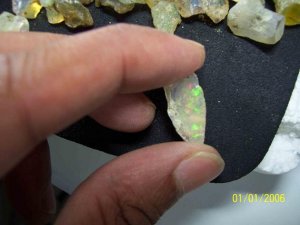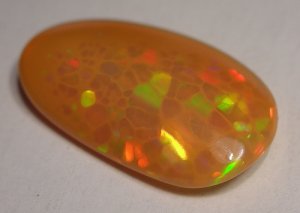You are using an out of date browser. It may not display this or other websites correctly.
You should upgrade or use an alternative browser.
You should upgrade or use an alternative browser.
name of this opal.....and this...and this.....?
- Thread starter daniiopal
- Start date
- Status
- Not open for further replies. Please create a new topic or request for this thread to be opened.
dragonfly411
Ideal_Rock
- Joined
- Jun 25, 2007
- Messages
- 7,378
I don''t know but it is prettyyy!!


- Joined
- Feb 17, 2004
- Messages
- 1,104
There are names for all the opal types you''ve posted. But I''ve learned in several decades of cutting and studying precious opal that nothing starts arguments faster than making nearly any kind of declarative statement about it.
To minimize that problem I''m posting the most recent work on opal nomenclature I know of. Australia produces an estimated 90% of the world''s gem opal so most other producing countries follow their lead on names to simplify communications in the trade. Careful study will provide answers to most of your questions.
As for the little nodules, the answers probably lie with mineralogists who can explain and name those particular methods of opal formation. But the areas with play of color in them will fall into one of the classifications below.
A New Era For Opal Nomenclature>
A wonderful new book, "Opal, The Phenomenal Gemstone," has recently been released by Lithographie LLC, ISBN 978-0-9790998-0-9
Richard M.
To minimize that problem I''m posting the most recent work on opal nomenclature I know of. Australia produces an estimated 90% of the world''s gem opal so most other producing countries follow their lead on names to simplify communications in the trade. Careful study will provide answers to most of your questions.
As for the little nodules, the answers probably lie with mineralogists who can explain and name those particular methods of opal formation. But the areas with play of color in them will fall into one of the classifications below.
A New Era For Opal Nomenclature>
A wonderful new book, "Opal, The Phenomenal Gemstone," has recently been released by Lithographie LLC, ISBN 978-0-9790998-0-9
Richard M.
daniiopal
Rough_Rock
- Joined
- Dec 5, 2008
- Messages
- 57
thank you richard i''ll check the link now....this is the back of the stone...i found it in a small nodule and grinded off the ironstone to find a small piece of dark black base with color right in the middle of the orange base which is colorful itself, so just polished the whole piece....am curious to know the name of the black part also as its not the same as australian black opal.Date: 1/8/2009 1:31:01 PM
Author: Richard M.
There are names for all the opal types you''ve posted. But I''ve learned in several decades of cutting and studying precious opal that nothing starts arguments faster than making nearly any kind of declarative statement about it.
To minimize that problem I''m posting the most recent work on opal nomenclature I know of. Australia produces an estimated 90% of the world''s gem opal so most other producing countries follow their lead on names to simplify communications in the trade. Careful study will provide answers to most of your questions.
As for the little nodules, the answers probably lie with mineralogists who can explain and name those particular methods of opal formation. But the areas with play of color in them will fall into one of the classifications below.
A New Era For Opal Nomenclature>
A wonderful new book, ''Opal, The Phenomenal Gemstone,'' has recently been released by Lithographie LLC, ISBN 978-0-9790998-0-9
Richard M.

- Joined
- Jan 26, 2003
- Messages
- 22,146
It''s really good to see you here, Richard! I very much wish that my daughter had not lost the beautiful opal ring that you made for her sixteenth birthday, but it is not completely impossible that it will one day turn up somewhere in my parents'' house! We think it slipped off her finger in the house. Unless the dog ate it, we do not see how anyone would have thrown it out! My sister-in-law found her diamond engagement ring in her house about five years after losing it (and having another ring made since her ring was insured!). So there is always a slight bit of hope that it will turn up one day....
At any rate, when I see an opal, I think of you. One day I hope that I will be able to have you make my daughter another ring (with VS diamonds .
.
I hope you hang around here more, too!
Deborah

At any rate, when I see an opal, I think of you. One day I hope that I will be able to have you make my daughter another ring (with VS diamonds
I hope you hang around here more, too!
Deborah

- Joined
- Feb 17, 2004
- Messages
- 1,104
Date: 1/8/2009 4:02:15 PM
Author: daniiopal
Date: 1/8/2009 1:31:01 PM
thank you richard i''ll check the link now....this is the back of the stone...i found it in a small nodule and grinded off the ironstone to find a small piece of dark black base with color right in the middle of the orange base which is colorful itself, so just polished the whole piece....am curious to know the name of the black part also as its not the same as australian black opal.
These oddities crop up occasionally. Nature isn''t always predictable and orderly, thank heavens. Not all opal types fit into any single category neatly. The oddballs are often my favorite "keeper" stones because they have great beauty and personality. They''re usually hard to sell because consumers generally want the "safety" of conformity.
On my monitor your opal''s body tone appears mainly brownish. There''s a body tone chart for brown-hued stones similar to the black chart. Valuation is a little different but the grading method is the same.
Since you polished the piece with a natural (ironstone? rhyolite?) backing it probably would classify as a boulder opal. Boulders are graded for body tone the same way as blacks, when viewed face-up, but some of the grading details differ. Interesting stone.
Richard M.
- Joined
- Feb 17, 2004
- Messages
- 1,104
Date: 1/8/2009 10:29:44 PM
Author: AGBF
It''s really good to see you here, Richard! I very much wish that my daughter had not lost the beautiful opal ring that you made for her sixteenth birthday, but it is not completely impossible that it will one day turn up somewhere in my parents'' house! We think it slipped off her finger in the house. Unless the dog ate it, we do not see how anyone would have thrown it out!
I''m really sorry about that, Deborah. If the dog ate it I hope he had serious indigestion! With luck the ring will show up, unscathed, sooner rather than later.
My wife lost the first emerald/diamond ring I gave her. Several months afterward a sharp-eyed neighbor boy was visiting and he reached down and picked it up from underneath my car in the driveway. It was in perfect condition even though cars had driven millimeters near it dozens of times. I''ll never understand why we hadn''t noticed it previously. I hope you''ll have a similar "Wow!" moment with your daughter''s ring.
Richard M.
arjunajane
Ideal_Rock
- Joined
- Jan 18, 2008
- Messages
- 9,758
Whoa, TL thats awesome! It looks like an alien fish, lol.Date: 1/8/2009 10:44:14 PM
Author: tourmaline_lover
This is a very cool opal as well.
I'm usually not a fan of opal - for some reason I think of it as passe (probably as I live in Australia).
But these finds are really different and pretty, thanks for sharing!
- Joined
- Feb 17, 2004
- Messages
- 1,104
Date: 1/8/2009 4:24:09 PM
Author: The Joker
Hay Richard:
Thanks for the great information link about opals.
And I still love your avatar.
The Joker....
Hi. Hope the info is of some help.
The opal in my avatar is a spectacular big light crystal gem from Mintabe, Australia. The image doesn''t begin to capture it. The color flash is rather directional (best as a pendant stone) with awesome ultra-bright sheets of intense gold, green, pink, red, purplish red and an amazing shade of lavender that engulf the entire face, one at a time as it moves in the light. I''ve never seen another stone even remotely like it, and I''ve seen a great many fine opals.
Richard M.
- Joined
- Feb 17, 2004
- Messages
- 1,104
Date: 1/8/2009 11:23:47 PM
Author: arjunajane
I''m usually not a fan of opal - for some reason I think of it as passe (probably as I live in Australia).
Maybe that''s because it''s an opal with a "honeycomb" potch/color pattern so far found only in Ethiopia. I''ve never seen an Aussie opal like it. This material is fascinating: each "cell" has an unique color that turns on and off, going from spectral color to potch color like spectral arrays of fireflies as the stone moves in the light. The patterns of different colors can be mind-boggling.
Richard M.
arjunajane
Ideal_Rock
- Joined
- Jan 18, 2008
- Messages
- 9,758
Thanks for the info Richard - it does sound like a very interesting effect!Date: 1/8/2009 11:37:41 PM
Author: Richard M.
Date: 1/8/2009 11:23:47 PM
Author: arjunajane
I''m usually not a fan of opal - for some reason I think of it as passe (probably as I live in Australia).
Maybe that''s because it''s an opal with a ''honeycomb'' potch/color pattern so far found only in Ethiopia. I''ve never seen an Aussie opal like it. This material is fascinating: each ''cell'' has an unique color that turns on and off, going from spectral color to potch color like spectral arrays of fireflies as the stone moves in the light. The patterns of different colors can be mind-boggling.
Richard M.
By my comment earlier, I guess its because we are so used to seeing opal souvenirs on every single family camping trip/excursion, so thats where that attitude of "meh, opal"

You are right, I have never seen anything like above and would love to see it in fine jewellery

- Joined
- Feb 17, 2004
- Messages
- 1,104
Date: 1/9/2009 12:38:51 AM
Author: arjunajane
Date: 1/8/2009 11:37:41 PM
Thanks for the info Richard - it does sound like a very interesting effect!
I think the color pattern would be classified as true Harlequin, although the effect is very different than Harlequin stones from Oz. Isn''t it wonderful that there always appears to be something new under the sun? That''s what makes gems so fascinating.
Richard M.
arjunajane
Ideal_Rock
- Joined
- Jan 18, 2008
- Messages
- 9,758
Agreed 100%. I am new to the world of coloured gems, and can feel myself getting addicted with every new discovery.Date: 1/9/2009 1:40:00 AM
Author: Richard M.
Date: 1/9/2009 12:38:51 AM
Author: arjunajane
Date: 1/8/2009 11:37:41 PM
Thanks for the info Richard - it does sound like a very interesting effect!
I think the color pattern would be classified as true Harlequin, although the effect is very different than Harlequin stones from Oz. Isn''t it wonderful that there always appears to be something new under the sun? That''s what makes gems so fascinating.
Richard M.
(sorry daniiopal for the slight threadjack).
- Joined
- Jan 26, 2003
- Messages
- 22,146
I took a couple of pictures of the opal ring Rick made for me on my daughter's sixteenth birthday, i.e. before she lost it! Unfortunately the two pictures I have of it were taken on my hand, not hers. Nonetheless, one can see that it was a lovely ring. The allusion I made to VS quality diamonds in one posting is because Rick and I decided to go with VS quality diamonds even though the stones were so tiny that one could hardly see them! I just wanted to give my daughter a very special, little ring for a special occasion. Well, I did!
C'est la vie!
Deborah


C'est la vie!
Deborah


- Joined
- Jan 26, 2003
- Messages
- 22,146
Here is the other photograph of the ring. As I have said, seeing the ring on my hand doesn''t do it justice. It was made for my daughter''s hand. And not only was it made for her hand, not only are her hands younger and her fingers far slimmer, but she is far more likely at any given time to have a manicure!
Deborah


Deborah


- Status
- Not open for further replies. Please create a new topic or request for this thread to be opened.
Celebrating Mothers And Mentors This Mother's Day
Celebrating Mothers And Mentors This Mother's Day - 05/05
Did You Miss the April 2024 Jewels of the Weeks?
Did You Miss the April 2024 Jewels of the Weeks? - 04/26












300x240.png)